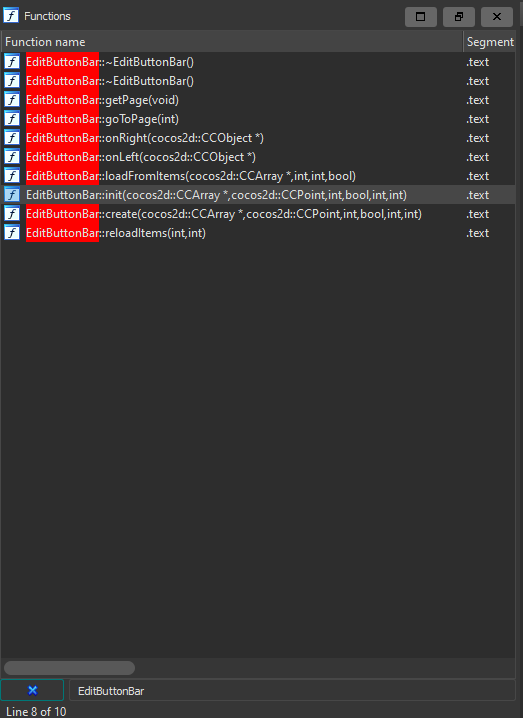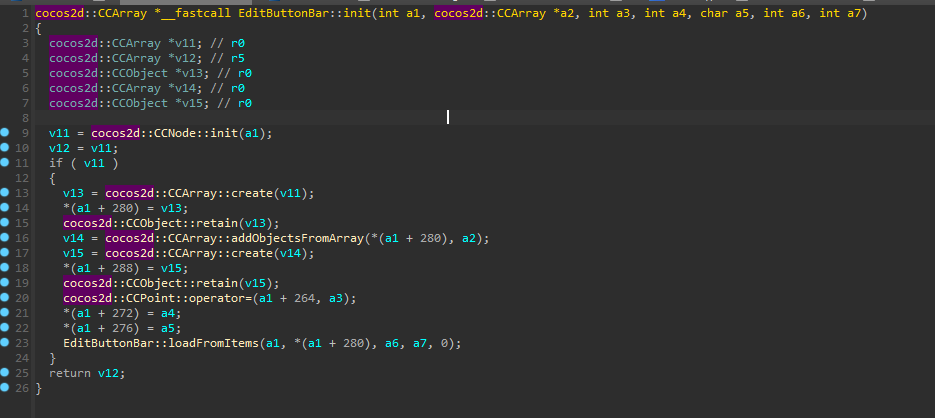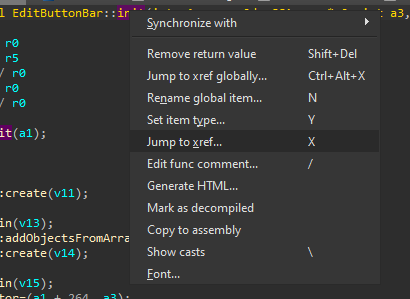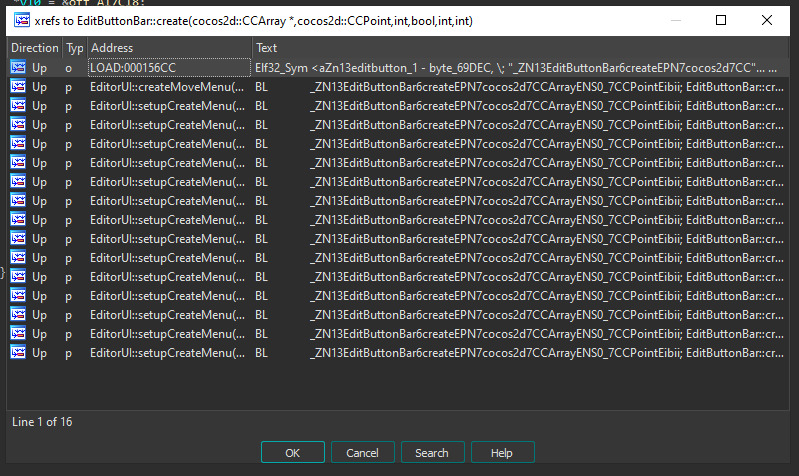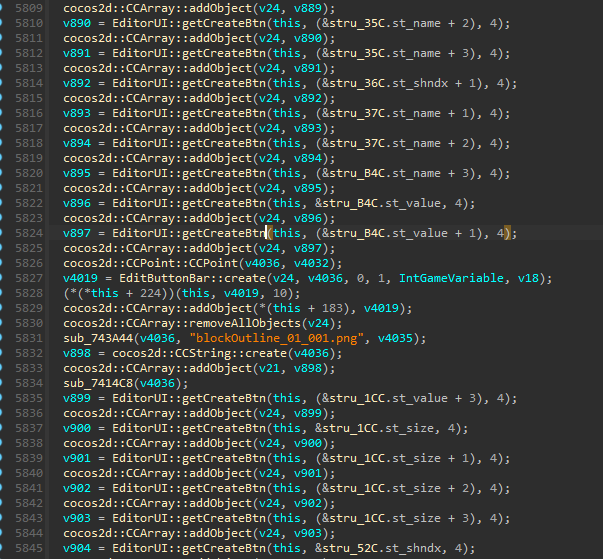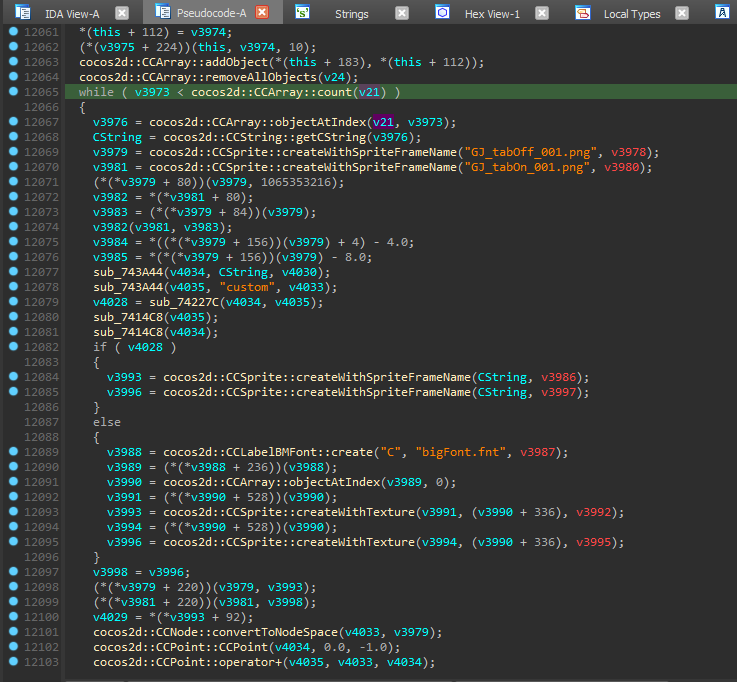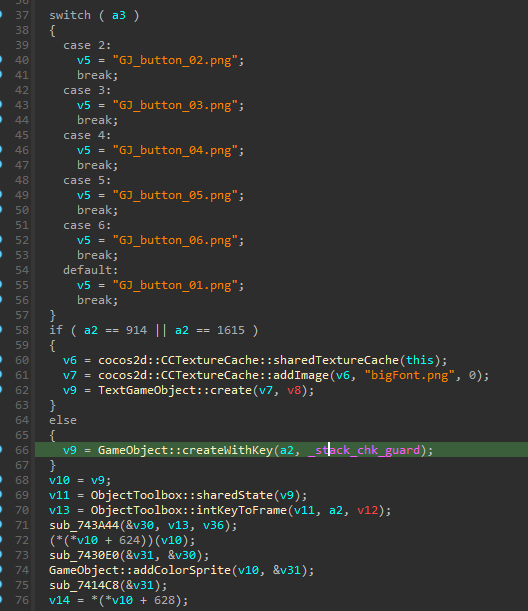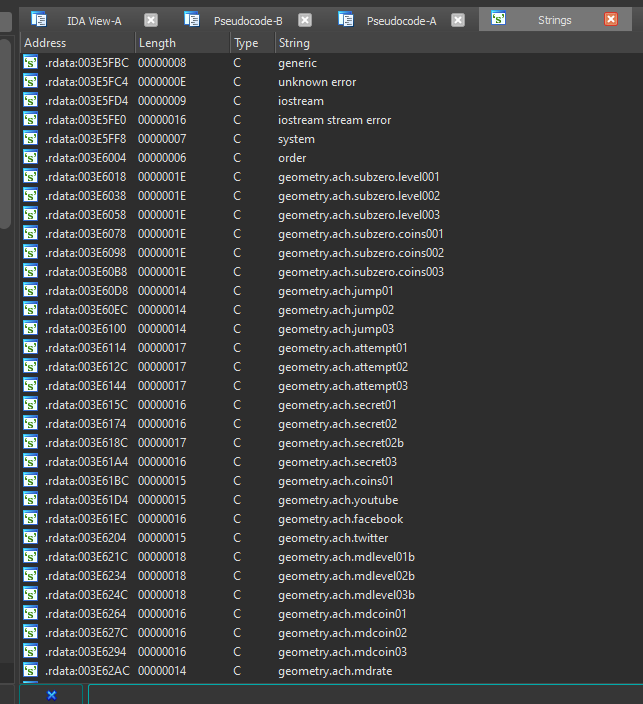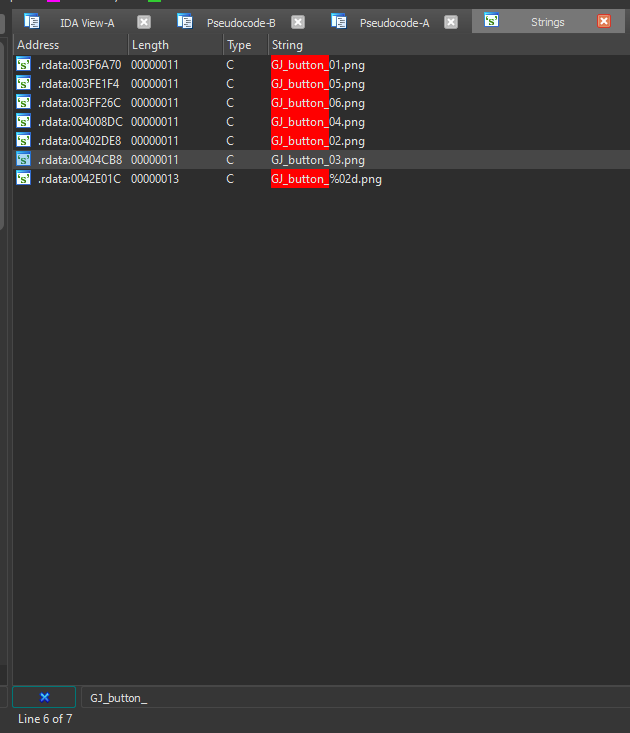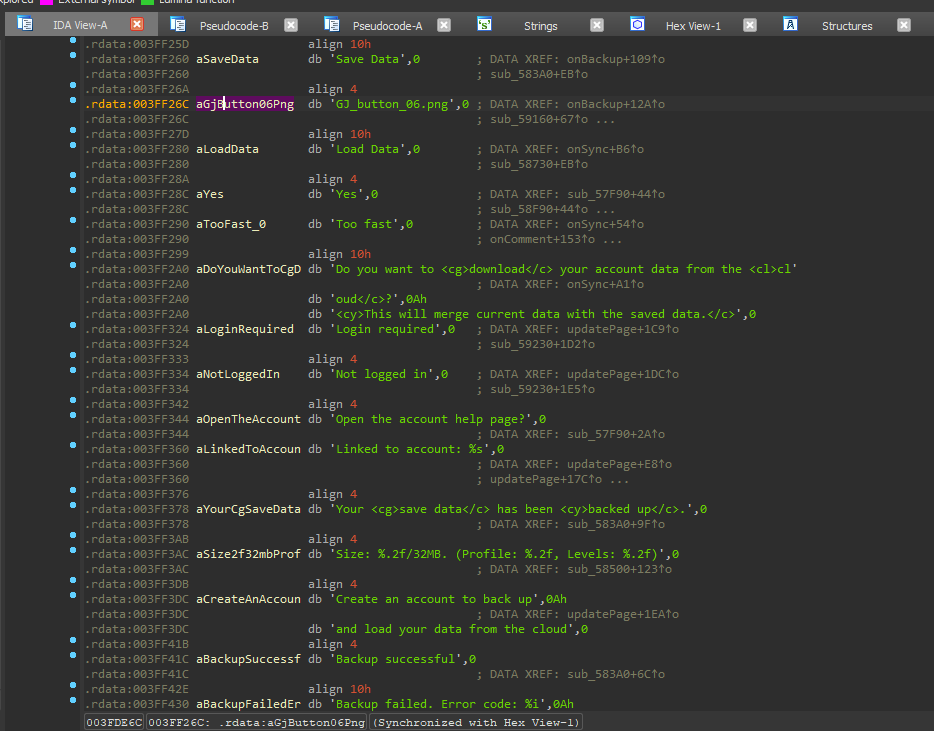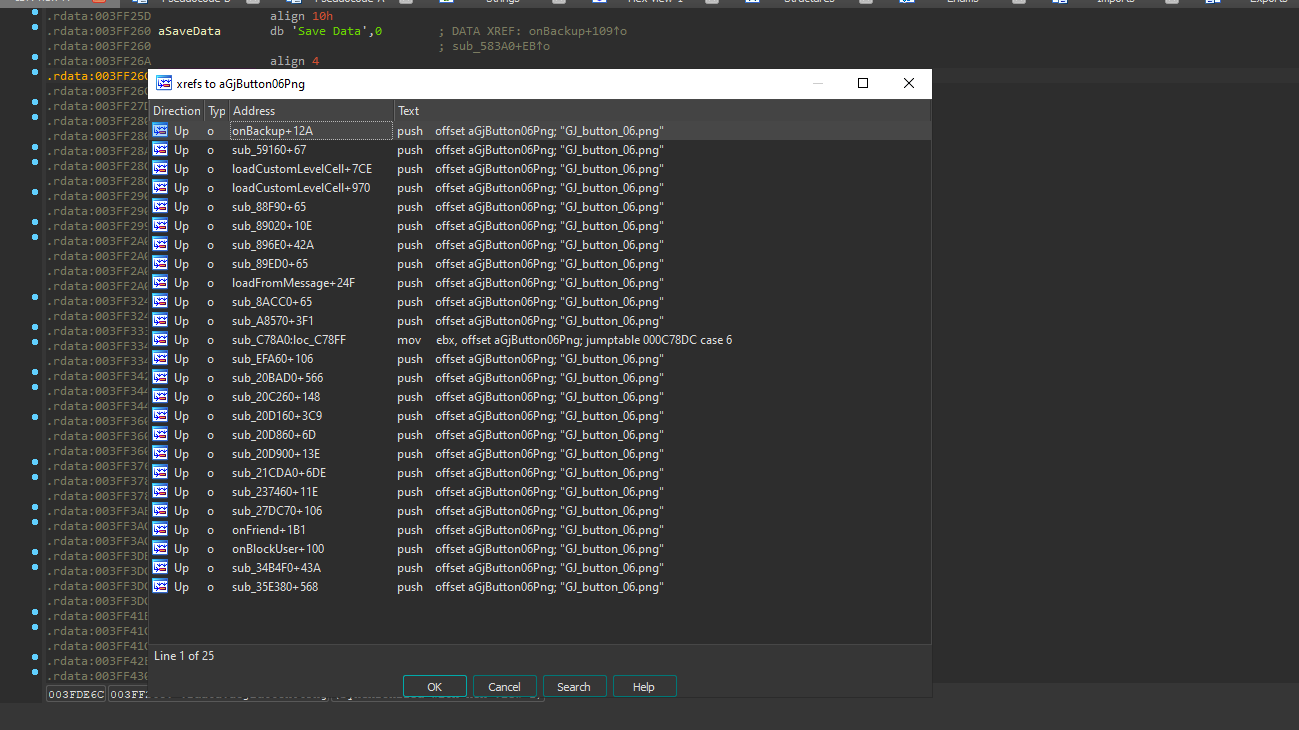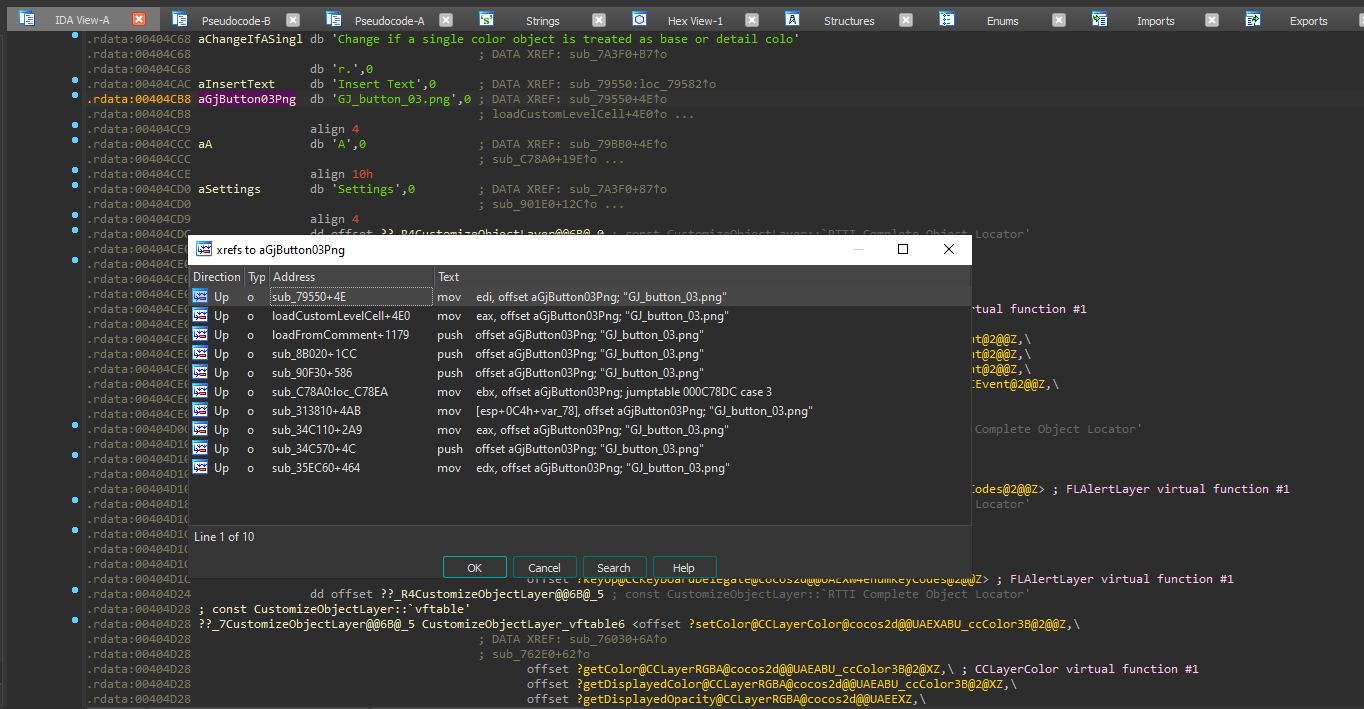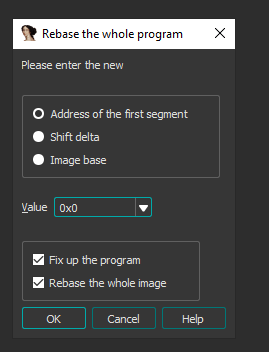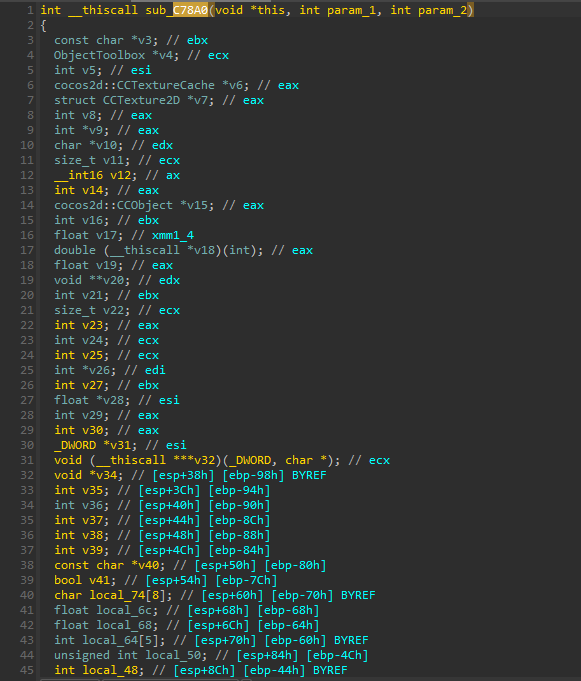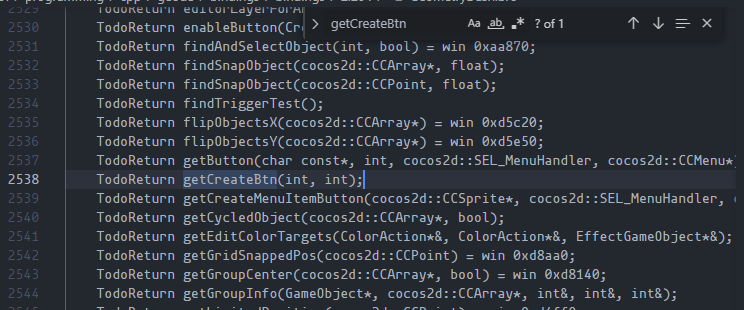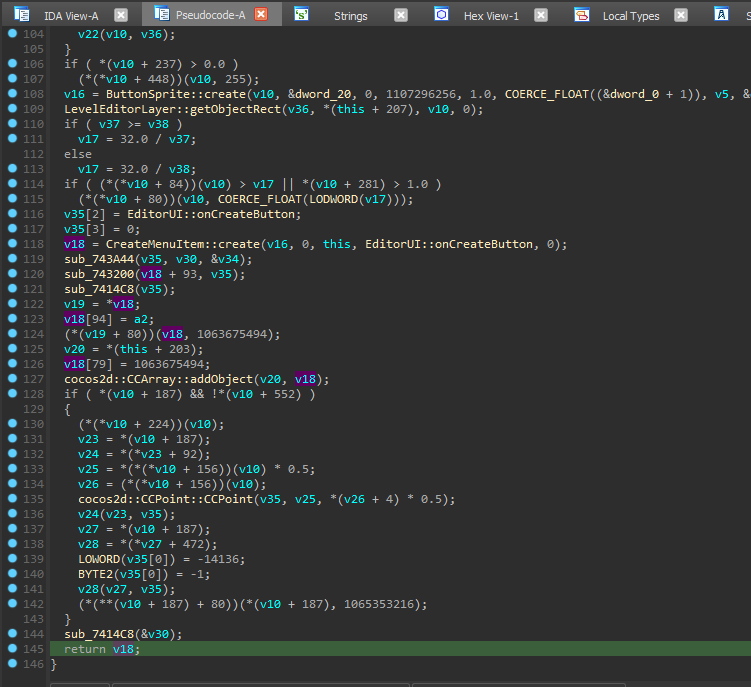I want to note that, you should read this from the VSCode markdown preview, it includes images.
Also i need to note that i will use IDA Pro for this since i really don't know how to use Ghidra that well.
However, it is possible to do it on Ghidra too.
Also, any question please let me know!
We need to load the binaries in IDA Pro to analyze them, since android has symbols and windows doesn't we need to load both of them.
Our goal here is to add a new object to the editor but how do we even start searching for it?
My approach was to first try and see what was the class of the added objects in the editor, we can do this using DevTools!
Here is what i got while searching:

EditButtonBar is probably what we are searching for.
The devtools show there is around 15 of them which matches with the number of tabs the editor has for objects. Jackpot!
We now need to search EditButtonBar in the Android binary (since it has symbols) and see what it does.
There is multiple methods here but we are interested in the EditButtonBar::init
(I could probably have used
EditButtonBar::reloadItemsbut it's easier to use the init for just adding already existing items)
Something something load from items. We can tell by logic this is what loads the ingame items. To confirm this, let's search the xrefs of the function!
Right Click - Jump to xref
(Or just press x)
Wha- There is only the create! (ignoring the elf (first element) stuff thats android only and is never used)
Of course, init must ONLY be called by a create! This is a rule for cocos2dx, the init will always only be called by the create!
(Or almost always, there might be some rebel classes that don't do this... but most do)
We already know how to see xrefs, we will now double click the reference to EditButtonbar::create and check the xrefs to EditButtonbar::create.
Bingo!
There seems to be two functions EditorUI::createMoveMenu(void) and EditorUI::setupCreateMenu(void).
I think it's pretty obvious which one we choose, however if you are not sure, count how many calls are done from EditorUI::setupCreateMenu(void) to our function! It matches the number of tabs there are.
Reminder that we are still in the android binary
It will take quite a while to decompile this function so uh go grab a cup of tea meanwhile.
After the decompilation, we will be greeted with this:
Oh that's def how robtop adds objects, it's all hardcoded robtop style.
By just this image, we can tell some stuff.
- Objects in the tab are created with the
EditorUI::getCreateBtnfunction. It does some weirdstru_numberthing? and also passes a 4 as an argument - Then, this created object is added to a CCArray
v24 - After finishing adding all the needed objects, it calls
EditButtonBar::createwithv24first and some other values - We now can tell that
v24holds all the objects for certain tab - After that it adds the created tab to
this + 224which is a member ofEditorUI - Then proceeds to clean
v24 - Creates a CCString with the object that is shown in the tab selection button
- Adds it to another different array,
v21 - Repeats the whole process
Note, sub_743A44(v4036, "blockOutline_01_001.png", v4035); is the same as the next c++ code:
std::string v4036 = std::string("blockOutline_01_001.png");With v4036 being the variable that stores the string and v4035 just a leftover (bad decompilation)
sub_7414C8(v4036) is a destructor, destroys v4036 since it will no longer be used
You will learn this things with time really, there isn't a good way to tell when certain stuff is from the standard library, only by either guessing or reversing something you have wrote yourself and you know what it is and learn from it.
We are missing some key stuff here, we already know how it creates the object and adds it to the tabs. It will also add it ingame somewhere late in the function but that's done for us, we really don't have to reverse it.
Now, what in the world is &stru_number?
As it turns out, is faulty decompilation. Here is where knowing assembly is necessary.
Compare the assembly with the decompiled code:
There is something wrong right, where the hell is the struct?
We can pretty much by logic tell that the struct is meant to be the 0x64C that is shown in the assembly
We can corroborate this by going to the first object that is added

We can press Q in the dword_0 to convert it into a number, we will get:
MOVS R2, #4 ; int
MOVS R1, #1 ; int
MOV R0, R4 ; this
BL _ZN8EditorUI12getCreateBtnEii ; EditorUI::getCreateBtn(int,int)
So yeah! We can now tell that the R1, #1 is the Object ID. We will use this for our hooking!
We know that EditorUI::setupCreateMenu adds all the tabs and EditorUI::getCreateBtn is used to add an object.
EditorUI::getCreateBtn has 2 ints as arguments, one is for the object ID and the other one we don't know but it's almost always 4.
We also know that EditButtonBar::create is used to create a tab with the objects!
So we hook EditorUI::setupCreateMenu and add our own object right?
As it turns out. At the end of EditorUI::setupCreateMenu it checks v21, iterates throught it and then creates the tabs!
This is bad! We can't add our own object now because objects were already added! (Or if we were to hook the start, we can't add them since the tabs arent created yet!)
What do we do????
Let's think a bit, we figured out EditButtonBar::create needs a CCArray* with our objects. If we want to add an object, why don't we just hook it add modify the array to add ours?
Bingo! We can do that, by modifying the function array we can add our own object! Let's do that!
We now have to do actual coding #scary
Let's hook EditButtonBar::create and add our own object!
#include <Geode/Geode.hpp>
#include <Geode/modify/EditButtonBar.hpp>
using namespace geode::prelude;
class $modify(EditButtonBar) {
bool init(cocos2d::CCArray* objects, cocos2d::CCPoint p1, int id, bool p3, int p4, int p5) {
if (!EditButtonBar::init(objects, p1, id, p3, p4, p5)) return false;
/*
We need to recreate this:
v3968 = EditorUI::getCreateBtn(this, (&stru_BCC.st_name + 1), 4);
cocos2d::CCArray::addObject(v24, v3968);
*/
return true;
};
};Note, always hook the "init" instead of "create".
Oh uh! We found an issue, we can't call EditorUI::getCreateBtn since we are not inside the EditorUI class!
How do we access it?
- Recreate the entire function
- Make a hacky thing and save the
EditorUIpointer to a global variable
Guess which one is easier lol
Let's hook EditorUI::init, save the this pointer to a global variable and use it!
#include <Geode/Geode.hpp>
#include <Geode/modify/EditButtonBar.hpp>
// Remember to add modify include for each class youre modifying!
#include <Geode/modify/EditorUI.hpp>
using namespace geode::prelude;
EditorUI* editorUI = nullptr;
class $modify(EditorUI) {
bool init(LevelEditorLayer* layer) {
if (!EditorUI::init(layer))
return false;
editorUI = this;
return true;
}
};
class $modify(EditButtonBar) {
bool init(cocos2d::CCArray* objects, cocos2d::CCPoint p1, int id, bool p3, int p4, int p5) {
if (!EditButtonBar::init(objects, p1, id, p3, p4, p5)) return false;
// No need to access with m_fields since its a global variable.
auto obj = editorUI->getCreateBtn(1, 4);
objects->addObject(obj);
return true;
};
};Let's go! Now let's compile the mod!
Aw god dammit, we don't have the address of getCreateBtn neither we have it's return type.
Let's get them then!
There is a lot of ways to get the address of stuff, I will use 1 method here which will lead us to the answer.
Let's take a look at the decompilation of getCreateBtn
switch ( a3 )
{
case 2:
v5 = "GJ_button_02.png";
break;
case 3:
v5 = "GJ_button_03.png";
break;
case 4:
v5 = "GJ_button_04.png";
break;
case 5:
v5 = "GJ_button_05.png";
break;
case 6:
v5 = "GJ_button_06.png";
break;
default:
v5 = "GJ_button_01.png";
break;
}This one is of our interest.
Also with this we can tell what the other int is for, it's for the background of the object!
With IDA Pro we can press shift + f12 to open the strings tab.
Let's search up any of the "GJ_Buttons" !
We need to think a bit. We are doing this to search functions that use THAT string. Since this are quite a common sprites, there will be multiple functions that show this sprite. Let's just make our lifes easier and choose the one that has the less references.
To search that, we double click any of them, i will select "GJ_button_06.png"
We now search for the xrefs! if you don't remember how to search for xrefs look up!
We will put our mouse in front of the aGjButton06Png since that's the declaration.
Holy molly, we have quite a lot of xrefs.
ptsss: we can tell it's the one with the Switch Case thing since our decompilation shows switch cases but let's think it doesnt exist for now
Let's repeat this process with all the GJ's until we find the one with less xrefs, this is to make our life easier after...
Aha! This one has a low amount.
We now have to. Go throught all of them. And search the one that matches our decompiled switch case.
Here is a video of me doing this:
After we found it we can go on top of the function to get the address!
You can rebase your IDA by going:
Edit > Segments > Rebase program
Rebase it to 0x0 so we don't have to do extra math to get the offsets.
Wait for it to rebase, shouldn't take that long.
Note: we are still in the windows binary
We can see the address of our function as the name of the decompilation!
0xC78A0 it is! Let's add it to our bindings!
Let's just search the name of the function getCreateBtn in the GeometryDash.bro file
We can just set it to
TodoReturn getCreateBtn(int, int) = win 0xC78A0;However, what about the return? We know it returns something because it's a "Create" and is used to add to the CCArray.
Let's look all the way down our decompilation since the return variable is always down.
Oh, it returns v18.
We need to backtrack what v18 is!
In this case, it's easy to tell since at the top of the image we can see v18 = CreateMenuItem::create(v16, 0, this, EditorUI::onCreateButton, 0);
It's now safe to asume that the return type is a CreateMenuItem*!
Note, it's a pointer because it uses CreateMenuItem::create. Creates mostly always return pointers!
Let's edit our broma with the return type.
CreateMenuItem* getCreateBtn(int, int) = win 0xC78A0;There we go! We can now use it in our code!
We ended up with this code:
#include <Geode/Geode.hpp>
#include <Geode/modify/EditButtonBar.hpp>
#include <Geode/modify/EditorUI.hpp>
using namespace geode::prelude;
EditorUI* editorUI = nullptr;
class $modify(EditorUI) {
bool init(LevelEditorLayer* layer) {
if (!EditorUI::init(layer))
return false;
editorUI = this;
return true;
}
};
class $modify(EditButtonBar) {
bool init(cocos2d::CCArray* objects, cocos2d::CCPoint p1, int id, bool p3, int p4, int p5) {
if (!EditButtonBar::init(objects, p1, id, p3, p4, p5)) return false;
// No need to access with m_fields since its a global variable.
auto obj = editorUI->getCreateBtn(1, 4);
objects->addObject(obj);
return true;
};
};This will indeed compile, however, it will add the object ID 1 to ALL the tabs since everytime a tab is created, the EditButtonBar::init is called.
If we look back at our decompilation (android) we can tell something
// ...
v4024 = EditButtonBar::create(v24, v4036, 9, 1, IntGameVariable, v18);
// ...
v4026 = EditButtonBar::create(v24, v4036, 10, 1, IntGameVariable, v18);
// ... more code ...
v3842 = EditButtonBar::create(v24, v4036, 11, 1, IntGameVariable, v18);The 3rd argument of EditButtonBar::create is always incrementing by 1!
That probably means that the 3rd argument is The ID of the tab! (There was no reason to add that, but robtop did lol thanks robtop)
We can now make an if to check which one
#include <Geode/Geode.hpp>
#include <Geode/modify/EditButtonBar.hpp>
#include <Geode/modify/EditorUI.hpp>
using namespace geode::prelude;
EditorUI* editorUI = nullptr;
class $modify(EditorUI) {
bool init(LevelEditorLayer* layer) {
if (!EditorUI::init(layer))
return false;
editorUI = this;
return true;
}
};
class $modify(EditButtonBar) {
bool init(cocos2d::CCArray* objects, cocos2d::CCPoint p1, int id, bool p3, int p4, int p5) {
if (!EditButtonBar::init(objects, p1, id, p3, p4, p5)) return false;
// Note: IDs start from 0
if (id == 1)
{
// No need to access with m_fields since its a global variable.
auto obj = editorUI->getCreateBtn(1, 4);
objects->addObject(obj);
}
return true;
};
};And that's it! We finished!!!... Didn't we?
As it turns out, editorUI will always be nullptr, why in the world...?
Let's check how the calls are done for our code.
EditorUI::init
EditButtonBar::init
-> OurEditorBarCode::init
-> OurEditorUICode::init
oh
We need to set the this pointer before the EditorUI::init and we need to add our object before the EditButtonBar::init.
Well that's easy, needs to be like this:
-> OurEditorUICode::init
EditorUI::init
-> OurEditorBarCode::init
EditButtonBar::init
Let's pass that into our cpp code!
#include <Geode/Geode.hpp>
#include <Geode/modify/EditButtonBar.hpp>
#include <Geode/modify/EditorUI.hpp>
using namespace geode::prelude;
EditorUI* editorUI = nullptr;
class $modify(EditorUI) {
bool init(LevelEditorLayer* layer) {
editorUI = this;
if (!EditorUI::init(layer))
return false;
return true;
}
};
class $modify(EditButtonBar) {
bool init(cocos2d::CCArray* objects, cocos2d::CCPoint p1, int id, bool p3, int p4, int p5) {
// Note: IDs start from 0
if (id == 1)
{
// No need to access with m_fields since its a global variable.
auto obj = editorUI->getCreateBtn(1, 4);
objects->addObject(obj);
}
if (!EditButtonBar::init(objects, p1, id, p3, p4, p5)) return false;
return true;
};
};We can simplify this.
#include <Geode/Geode.hpp>
#include <Geode/modify/EditButtonBar.hpp>
#include <Geode/modify/EditorUI.hpp>
using namespace geode::prelude;
EditorUI* editorUI = nullptr;
class $modify(EditorUI) {
bool init(LevelEditorLayer* layer) {
editorUI = this;
return EditorUI::init(layer);
}
};
class $modify(EditButtonBar) {
bool init(cocos2d::CCArray* objects, cocos2d::CCPoint p1, int id, bool p3, int p4, int p5) {
// Note: IDs start from 0
if (id == 1)
{
// No need to access with m_fields since its a global variable.
auto obj = editorUI->getCreateBtn(1, 4);
objects->addObject(obj);
}
return EditButtonBar::init(objects, p1, id, p3, p4, p5);
};
};For your use case, someone made a level named Object IDs with all object ids 😉
Change the ID to the one you want!
